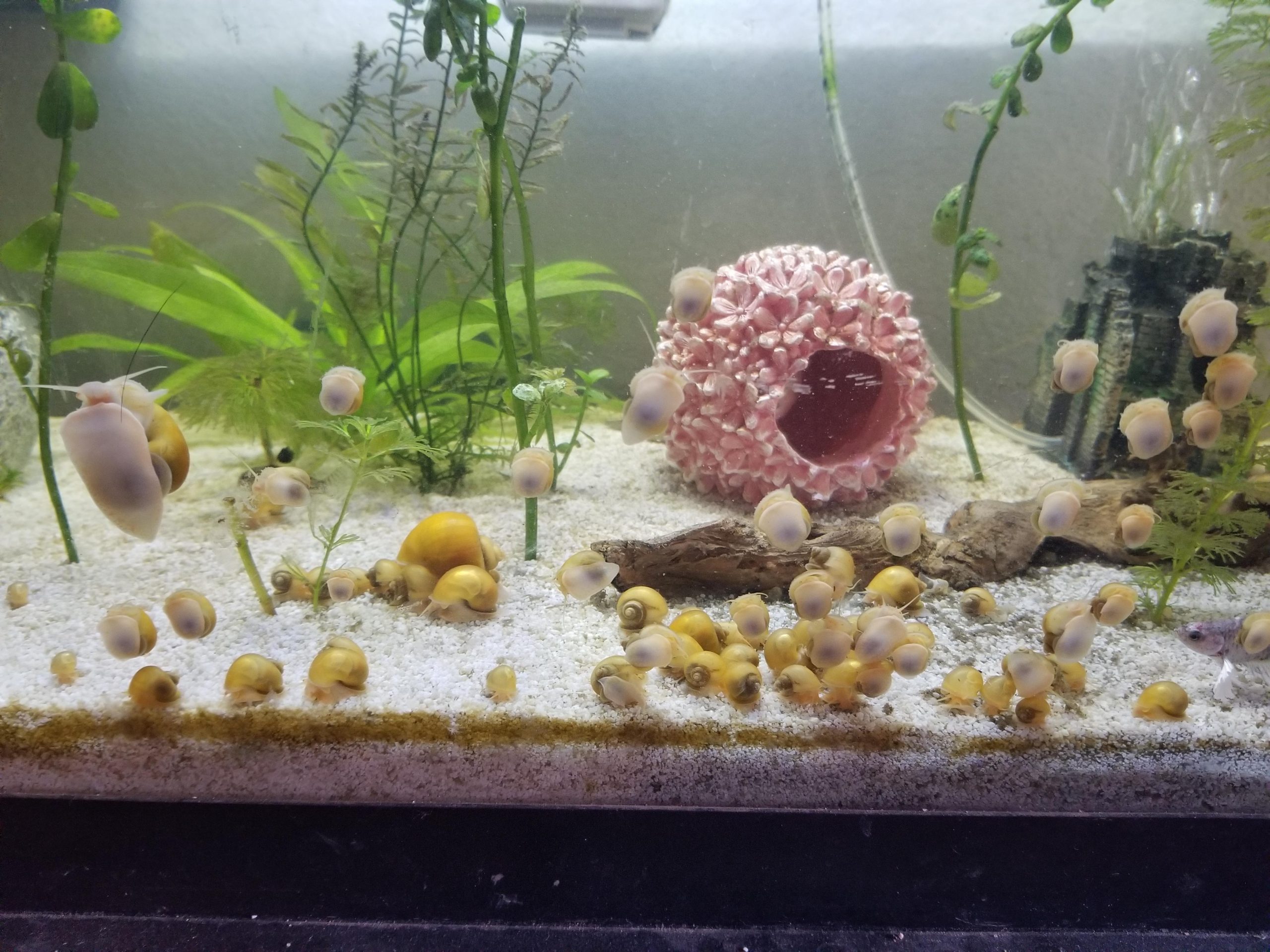Aquatic Knowledge
How to Get Rid of Snails in Aquarium Safely and Effectively
Snails can be an unexpected nuisance in your aquarium. While some aquarists appreciate the role they play in cleaning up excess food and algae, others find that snails quickly overpopulate the tank, causing more harm than good. If you’re struggling with a snail infestation, this guide will teach you how to get rid of snails in aquarium environments, offering a variety of methods to help control or eliminate these pests.
How to Get Rid of Snails in Aquarium: Identifying the Problem
Before you jump into removing snails, it’s crucial to understand the problem. Most aquarists first notice snails when they suddenly see a population boom. A few snails might not be an issue, but when they start multiplying, they can become overwhelming.
Common Snail Species and Their Characteristics

Pond Snails
Pond snails are small, with translucent shells that can quickly become a problem due to their rapid reproduction rate. These snails are frequently introduced to aquariums through plants and decorations. Pond snails are typically brown or greenish and can grow up to an inch in length. Their egg clusters are often found on plant leaves and other surfaces, appearing as jelly-like masses containing numerous tiny eggs.
Ramshorn Snails
Ramshorn snails are easily recognizable by their distinct coil-shaped shells, which resemble a ram’s horn. They come in various colors, including red, brown, and blue. While they can be beneficial in small numbers by helping to clean up algae and detritus, they can become problematic if their population grows too large. Ramshorn snails lay their eggs in clusters on hard surfaces, and their young are often visible shortly after hatching.
Malaysian Trumpet Snails
Malaysian trumpet snails have elongated, conical shells and are known for their burrowing behavior. They are beneficial in small numbers as they help aerate the substrate by burrowing, which prevents the buildup of toxic gases. However, their ability to reproduce rapidly can lead to overpopulation. These snails are nocturnal and often go unnoticed during the day, emerging at night to feed. Their egg capsules are usually attached to hard surfaces and can lead to a sudden increase in population if not controlled.
By familiarizing yourself with these common snail species and their characteristics, you can better identify and address infestations in your aquarium. Recognizing the early signs and understanding how to get rid of snails in aquariums is essential for maintaining a healthy aquatic environment.
Why Snails Overpopulate Aquariums
Understanding why snails overpopulate can help you better manage the problem. There are a few reasons for sudden population growth:
Introducing Snails Through New Plants and Decorations

One of the primary ways snails find their way into aquariums is through new plants and decorations. Snail eggs are often microscopic and can easily hitch a ride on the leaves of plants or within the crevices of decorations. These tiny eggs can go unnoticed until they hatch and begin to populate your tank. To prevent this and learn how to get rid of snails in aquarium environments, it’s crucial to thoroughly inspect and clean new plants and decorations before introducing them to your tank.
Overfeeding and Poor Aquarium Maintenance
Overfeeding your fish is another significant factor that can lead to a snail infestation. When you provide more food than your fish can consume, the uneaten food settles at the bottom of the tank, creating a perfect feeding ground for snails. Poor aquarium maintenance compounds this problem by allowing organic debris to accumulate, which serves as an additional food source for snails. Regular maintenance and controlled feeding are key strategies for how to get rid of snails in aquariums and prevent their return.
Hitchhiking Snails on New Fish
Snails or their eggs can also be introduced to your aquarium through new fish. Even a single snail or a cluster of eggs attached to a fish can lead to an infestation. To minimize this risk, always inspect new fish closely and quarantine them for a period before adding them to your main tank. This practice not only helps in how to get rid of snails in aquariums but also prevents the introduction of other potential pests and diseases.

Natural Methods to Get Rid of Snails

Introducing Snail-Eating Fish
Certain fish species, such as loaches and assassin snails, feed on snails. Adding these to your tank can help control the snail population naturally.
Examples: Loaches, Assassin Snails
Loaches, like the clown loach, are known snail predators. Assassin snails will hunt and eat other snails, helping to keep their numbers in check.
Using Vegetables as Snail Traps
Place vegetables like lettuce or cucumber slices in the tank overnight. Snails will be attracted to them, making it easy to remove them in the morning.
How to Set Up and Use Vegetable Traps
Anchor the vegetable slice to the bottom of the tank and remove it along with the attached snails the next day. Repeat this process until the snail population decreases.
Manual Removal
One of the most straightforward ways of tackling the problem is manual removal. Though it requires effort, this method is effective for quickly reducing snail numbers.
How to Remove Snails by Hand
Grab a net or your hands and physically remove as many snails as you can from your tank. While this won’t eradicate them entirely, it’s an easy way to reduce their numbers. Here’s how:
- Start early: Begin removing snails as soon as you notice them.
- Check regularly: Make a habit of checking your tank weekly for new snails.
- Use a siphon: During water changes, use a siphon to help pick up snails along with debris.
Use Traps to Catch Snails
If you’re not up for picking snails out by hand, you can use snail traps. These traps are available in pet stores, or you can create your own.
DIY Snail Traps
Making a snail trap is simple. Place a piece of lettuce or a slice of cucumber at the bottom of your tank overnight. In the morning, remove the vegetable, which should be covered in snails. Repeat the process until snail numbers are significantly reduced.
Chemical Treatments
Chemical treatments can be an effective method for how to get rid of snails in aquarium environments, especially if manual methods don’t work or you’re dealing with a severe infestation.
Copper-Based Medications
One of the most commonly used chemical treatments for snails is copper-based medication. These products are designed to kill invertebrates like snails, but they should be used with caution. Here’s why:
- Effectiveness: Copper is lethal to snails but can also harm other invertebrates like shrimp.
- Water changes: After using a copper-based product, it’s important to do several water changes to remove residual copper from your tank.
Aquarium-Safe Snail Killers
There are commercial snail killer products available that claim to be safe for fish and plants. Always read the label carefully and monitor your tank after application to ensure your fish are not negatively affected.
Biological Control Methods
Utilizing Snail-Eating Fish and Invertebrates: Adding natural predators, such as snail-eating fish and invertebrates, can help maintain a balanced snail population without chemicals.
The Role of Natural Predators in Controlling Snails: Natural predators keep snail numbers in check, creating a balanced ecosystem. They help control the population without the need for chemical treatments.
Compatibility with Other Aquarium Inhabitants: Ensure that snail-eating fish and invertebrates are compatible with your existing tank inhabitants to prevent stress and conflict.
Mechanical Methods
Installing Snail Traps: Commercial snail traps can be placed in the tank to capture snails. These traps are designed to attract snails and contain them for easy removal.
Using Gravel Vacuums: Gravel vacuums help remove snail eggs and debris from the substrate. Regular vacuuming can reduce the food sources that support snail populations.
Pros and Cons of Mechanical Methods: Mechanical methods are chemical-free and safe but may require consistent effort and may not completely eradicate snails on their own.
Conclusion
Getting rid of snails in your aquarium involves a combination of preventive measures, natural methods, chemical treatments, biological controls, and mechanical methods. By being proactive and consistent in your efforts, you can maintain a healthy, snail-free aquatic environment.
FAQs
How do I prevent snails from entering my aquarium?
To prevent snails from entering your aquarium, always quarantine new plants and fish, clean decorations thoroughly, and maintain good aquarium hygiene.
Are snails harmful to my aquarium?
In small numbers, snails are generally harmless and can even be beneficial. However, a large infestation can cause problems by overpopulating and consuming too much plant material.
Can snails be beneficial to my aquarium?
Yes, snails can be beneficial as they help clean up uneaten food and algae. They also aerate the substrate by burrowing.
How often should I clean my aquarium to prevent snails?
Regular maintenance, including weekly water changes and substrate vacuuming, is essential to prevent snail infestations.
What are the best snail-eating fish for my aquarium?
Loaches, such as the clown loach, and assassin snails are excellent choices for controlling snail populations in your aquarium.
